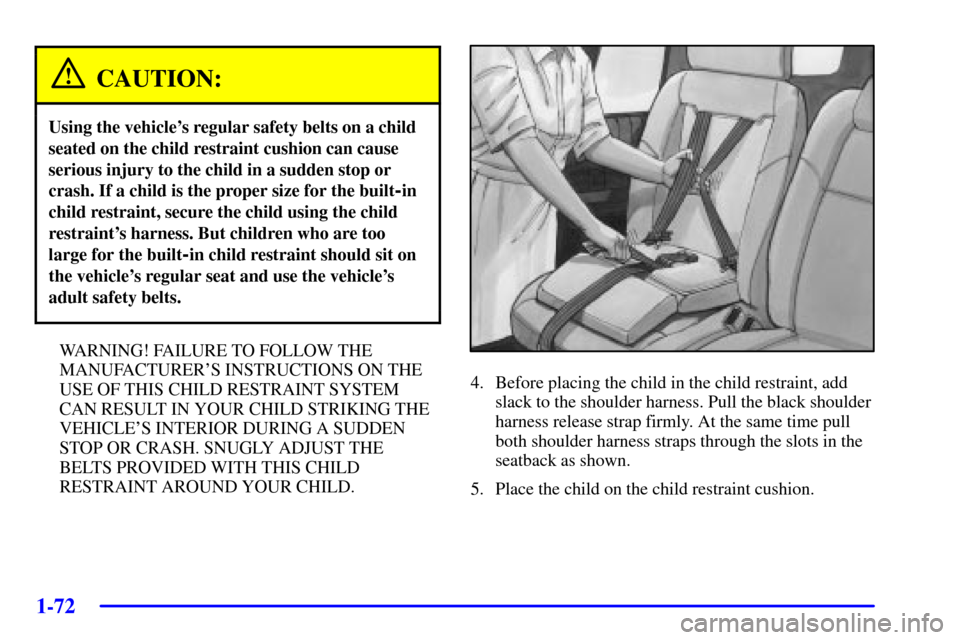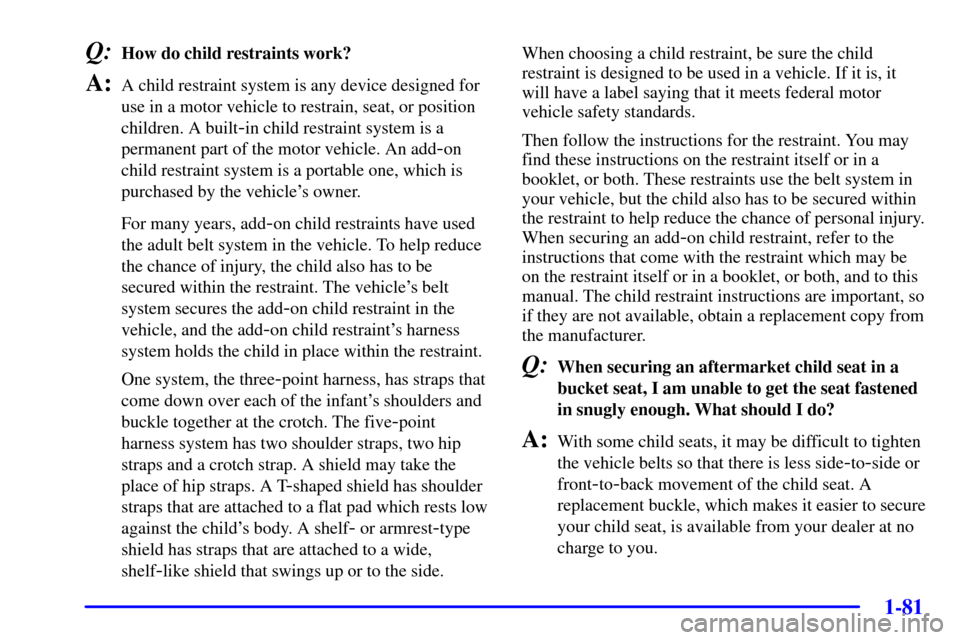Page 76 of 486
1-70 Securing a Child in the Built-In
Child Restraint
1. Raise the head restraint until the lower edge of the
head restraint is even with the top of the seatback.
2. Rotate the head restraint rearward until it touches the
top of the seatback. Make sure there is no gap
between the lower edge of the head restraint and the
top of the seatback.
Page 77 of 486
1-71
3. Lower the child restraint cushion.You'll be using the child restraint's harness (A)
to secure your child. Don't use the vehicle's
safety belts.
Page 78 of 486

1-72
CAUTION:
Using the vehicle's regular safety belts on a child
seated on the child restraint cushion can cause
serious injury to the child in a sudden stop or
crash. If a child is the proper size for the built
-in
child restraint, secure the child using the child
restraint's harness. But children who are too
large for the built
-in child restraint should sit on
the vehicle's regular seat and use the vehicle's
adult safety belts.
WARNING! FAILURE TO FOLLOW THE
MANUFACTURER'S INSTRUCTIONS ON THE
USE OF THIS CHILD RESTRAINT SYSTEM
CAN RESULT IN YOUR CHILD STRIKING THE
VEHICLE'S INTERIOR DURING A SUDDEN
STOP OR CRASH. SNUGLY ADJUST THE
BELTS PROVIDED WITH THIS CHILD
RESTRAINT AROUND YOUR CHILD.
4. Before placing the child in the child restraint, add
slack to the shoulder harness. Pull the black shoulder
harness release strap firmly. At the same time pull
both shoulder harness straps through the slots in the
seatback as shown.
5. Place the child on the child restraint cushion.
Page 79 of 486
1-73
6. Select only one side of the harness. Place the harness
over the child's shoulder.
7. Push the latch plate (B) into the buckle until it clicks.
Be sure the buckle is free of any foreign objects
that may prevent you from securing the latch plates.
If you can't secure a latch plate, see your dealer for
service before using the child restraint.
8. Place the other side of the harness over the
child's shoulder.
9. Push the latch plate into the buckle until it clicks.10. Pull up on both latch plates to make sure they
are secure.
Page 84 of 486
1-78
4. Then press the leg rest firmly into the seatback, and
secure it by pressing the upper corners against the
fastener strips on the seatback.5. Rotate the head restraint forward and push it all the
way down.
Just like the other restraint systems in your vehicle, your
built
-in child restraint needs to be periodically checked
and may need to have parts replaced after a crash. See
ªChecking Your Restraint Systemsº and ªReplacing Seat
and Restraint System Parts After a Crashº in the Index.
Page 87 of 486

1-81
Q:How do child restraints work?
A:A child restraint system is any device designed for
use in a motor vehicle to restrain, seat, or position
children. A built
-in child restraint system is a
permanent part of the motor vehicle. An add
-on
child restraint system is a portable one, which is
purchased by the vehicle's owner.
For many years, add
-on child restraints have used
the adult belt system in the vehicle. To help reduce
the chance of injury, the child also has to be
secured within the restraint. The vehicle's belt
system secures the add
-on child restraint in the
vehicle, and the add
-on child restraint's harness
system holds the child in place within the restraint.
One system, the three
-point harness, has straps that
come down over each of the infant's shoulders and
buckle together at the crotch. The five
-point
harness system has two shoulder straps, two hip
straps and a crotch strap. A shield may take the
place of hip straps. A T
-shaped shield has shoulder
straps that are attached to a flat pad which rests low
against the child's body. A shelf
- or armrest-type
shield has straps that are attached to a wide,
shelf
-like shield that swings up or to the side.When choosing a child restraint, be sure the child
restraint is designed to be used in a vehicle. If it is, it
will have a label saying that it meets federal motor
vehicle safety standards.
Then follow the instructions for the restraint. You may
find these instructions on the restraint itself or in a
booklet, or both. These restraints use the belt system in
your vehicle, but the child also has to be secured within
the restraint to help reduce the chance of personal injury.
When securing an add
-on child restraint, refer to the
instructions that come with the restraint which may be
on the restraint itself or in a booklet, or both, and to this
manual. The child restraint instructions are important, so
if they are not available, obtain a replacement copy from
the manufacturer.
Q:When securing an aftermarket child seat in a
bucket seat, I am unable to get the seat fastened
in snugly enough. What should I do?
A:With some child seats, it may be difficult to tighten
the vehicle belts so that there is less side
-to-side or
front
-to-back movement of the child seat. A
replacement buckle, which makes it easier to secure
your child seat, is available from your dealer at no
charge to you.
Page 88 of 486

1-82 Where to Put the Restraint
Accident statistics show that children are safer if they
are restrained in the rear rather than the front seat.
General Motors, therefore, recommends that child
restraints be secured in a rear seat including an infant
riding in a rear
-facing infant seat, a child riding in a
forward
-facing child seat and an older child riding in a
booster seat. Never put a rear
-facing child restraint in
the front passenger seat. Here's why:
CAUTION:
A child in a rear-facing child restraint can be
seriously injured or killed if the right front
passenger's air bag inflates. This is because the
back of the rear
-facing child restraint would be
very close to the inflating air bag. Always secure
a rear
-facing child restraint in a rear seat.
You may secure a forward-facing child restraint
in the right front seat, but before you do, always
move the front passenger seat as far back as it
will go. It's better to secure the child restraint in
a rear seat.
Wherever you install it, be sure to secure the child
restraint properly.
Keep in mind that an unsecured child restraint can move
around in a collision or sudden stop and injure people in
the vehicle. Be sure to properly secure any child
restraint in your vehicle
-- even when no child is in it.
Top Strap
Some child restraints have a top strap, or ªtop tether.º
It can help restrain the child restraint during a collision.
For it to work, a top strap must be properly anchored to
the vehicle. Some top strap
-equipped child restraints are
designed for use with or without the top strap being
anchored. Others require the top strap always to be
anchored. Be sure to read and follow the instructions
for your child restraint. If yours requires that the top
strap be anchored, don't use the restraint unless it is
anchored properly.
If the child restraint does not have a top strap, one can
be obtained, in kit form, for many child restraints.
Ask the child restraint manufacturer whether or not a kit
is available.
Page 89 of 486
1-83
In Canada, the law requires that forward-facing child
restraints have a top strap, and that the strap be
anchored. In the United States, some child restraints also
have a top strap. If your child restraint has a top strap, it
should be anchored.Don't use a child restraint that requires a top strap in the
right front passenger's position because there's no place
to anchor the top strap.
Anchor the top strap to one of the following anchor
points. Be sure to use an anchor point located on the
same side of the vehicle as the seating position where
the child restraint will be placed. If you have an
adjustable head restraint, route the top strap under it.
Once you have the top strap anchored, you'll be ready to
secure the child restraint itself. Tighten the top strap
when and as the child restraint manufacturer's
instructions say.